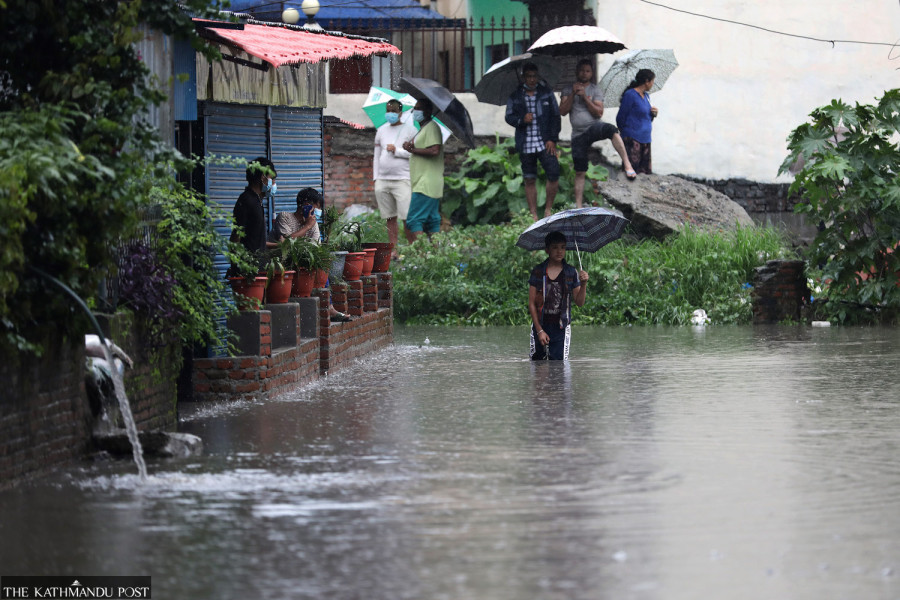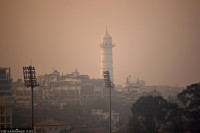Climate & Environment
Authorities ill-prepared for looming monsoon extremes
Nepal’s agencies have never learned from past failures in disaster management, lament disaster experts.
Arjun Poudel
Last year, in the aftermath of the earthquake in Jajarkot and Rukum West districts, several displaced people, including new mothers, newborns and elderly people died of hypothermia and other cold-related ailments.
Even after months of the disaster, authorities were scrambling to supply tarpaulin tents and warm clothes to the displaced people.
And in recent weeks, many fire victims, including women, children and elderly people, were forced to reside in the open for days and survive on beaten rice and dry noodles due to the failure of the relevant authorities to make arrangements for plastic tents to build makeshift shelters on time.
Many victims of forest fires across the country are still facing financial hardships and cannot afford hospital treatment or purchase medicines and food.
“My sister-in-law told me on the phone that she could not arrange the money needed for the treatment. She sounded helpless,” said Sabitri Budhamagar, cousin sister of Gyan Bahadur Budhamagar, a local from ward 3 of Taman Khola Rural Municipality in Baglung district, who was critically injured while battling a forest fire near his home last week of April. “She has instead sent two mana [around a kilo] of ghee.”
These were common refrains among many disaster incidents in which concerned agencies failed miserably to respond, and victims suffered even after months of disasters.
This year, agencies, both national and international, predicted above-average rainfall and above-average maximum temperature in the upcoming monsoon, which could raise disaster-related incidents— flooding in plains and landslides in hills and mountainous regions.
What concerned disaster experts is the lackadaisical approach of authorities concerned to prevent the risks, protect the victims, prepare for the worst-case scenario, rescue the victims, and rehabilitate them.
“Every year, government agencies prepare monsoon-preparedness plans, but we all know such plans made in seminars at the five-star hotels are not very effective,” said Santona Devkota, an expert on disaster risk reduction. “Victims die months after disasters due to failure of authorities to provide relief on time.”
Every year, the government allocates huge funds for disaster management. However, disaster victims remain deprived of help. Experts say this is not due to shortage of resources but mismanagement and lack of coordination among agencies concerned under the three tiers of government.
Officials at the National Disaster Risk Reduction and Management Authority under the Ministry of Home Affairs say local governments are the first responders to disasters. However, agencies under local governments lack trained human and financial resources.
“Authorities concerned should be prepared to deal with the worst-case scenarios, human resources should be trained, and funds should be allocated accordingly,” said Devkota. ‘Early warning systems should be made effective, simulation exercises should be carried out to deal with emergencies.”
Authorities spent several millions of rupees on flying choppers rather than on providing relief materials to the victims in the aftermath of the disasters.
Experts also suggest stockpiling foodstuffs, medicines, and relief materials at regional and district levels, working for better coordination among agencies concerned under all three tiers of government, and creating basket funds while responding to disaster-related incidents. They say that the responsibility of the authorities concerned does not end immediately after the disaster, as the risk of disease outbreaks rises in the aftermath.
Meanwhile, the National Disaster Risk Reduction and Management Authority said it is in the last stage of completing the monsoon preparedness plan. Officials say the new plan envisages a central command centre for coordination among all agencies concerned.
“Landslide incidents could occur in districts of hills and mountains and Tarai regions could witness floodings in the upcoming monsoon,” said Dijan Bhattarai, spokesperson at the authority. “We have been preparing our preparedness plan considering all possible untoward incidents.”




 7.12°C Kathmandu
7.12°C Kathmandu










